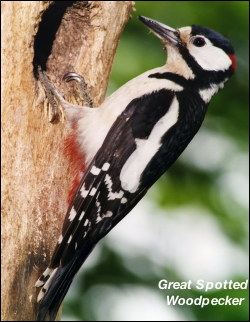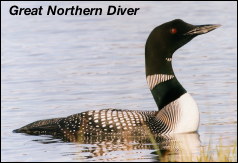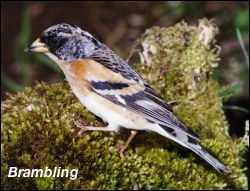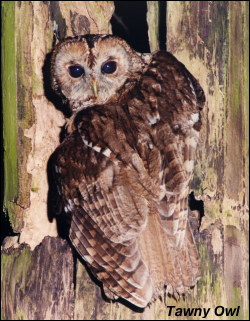November 23, 2009 at 5:19 am

Last weekend was spent at Banchory in Aberdeenshire attending Mike Madders memorial service on the Monday. A beautiful part of the country but not much seen in the way of wildlife.
In the garden the Collared Doves have increased to a maximum of seventeen with a Great Spotted Woodpecker a regular daily visitor.
Full launch of the new DVD Polar Bears and other Wildlife of Spitsbergen will be made next weekend but if anyone wants to post me a cheque for £16 to 3 Saxonholme Road, Castleton, Rochdale. OL11 2YA I will forward the DVD by return of post. It will be possible to pay through my website next weekend.
November 15, 2009 at 7:47 am

Not quite as spectacular as this photo of a Great Northern Diver in Summer plumage but it was good to see one at Hollingworth Lake this week. It has been there now over a week which is a long time for a vagrant passage bird.
In Hopwood this week a large party of Tits comprised of a least twenty one Long Tailed Tits – the most I have seen together locally for many years. A Woodcock was also flushed on the fourteenth and a Green Woodpecker seen on the eleventh. One flock of thirty two Fieldfares is still the biggest I have seen this Winter and all the berries are still waiting to be eaten.
In the garden there is now a young female Sparrow Hawk coming as well as the old male bird. She spent some time one day trying to entice the House Sparrows out of the thick privet hedge but with no success.
November 9, 2009 at 1:18 pm

Last weeks note about the Sparrowhawk was somewhat premature as he returned twice during the week and on one occasion he caught a Goldfinch on the rockery at the back of our garden! Despite all this the Collared Dove total has now increased to fifteen and there seems to be no end to where they are coming from.
On Hopwood a Buzzard was seen on the seventh. Flower wise there are still Foxglove and Red Campion in flower – global warming I suppose.
It has rained nearly every day this week with more than two inches having fallen. There are still very few Winter thrushes about and it looks like Bramblings are going to be the star birds this Winter.
November 2, 2009 at 1:11 am

There can be no finer Beech woods in East Lancashire than Tandle Hill Country Park at Royton. This year there has been a good crop of fruit and as a result the wood now has fifty plus Wood Pigeons feeding amongst the leaves. On the thirtieth October a visit produced several Bramblings, a Woodcock and my first Fieldfares of the Winter – the latest date I have ever recorded for their arrivals.
On Hopwood a Green Woodpecker was seen on the twenty ninth and three Cormorants have been roosting on pylons by the canal.
In the garden the Collared Doves have now increased to a maximum of twelve. The male Sparrowhawk has been three times during the week but not caught anything – as far as we know!
October 26, 2009 at 1:25 am

I have spent most of this week working on the Spitsbergen DVD so I have not had much time for ‘birding’
On Hopwood on two separate days I had flocks of thirty five Siskins and eighteen Redpolls – all feeding in the Birch trees. Redwings are still around but I have yet to see Fieldfare – my latest date ever.
Good numbers of Goldfinches are in the garden plus nineteen Greenfinches on one day. Goldcrests have been in our pine tree, two wrens and two Coal Tits were seen on another day and today, with the clock being adjusted, a very large Tawny Owl flew into the garden at 5.10pm.
October 18, 2009 at 1:34 pm

With the first frosts of Winter this week the local Hedgehogs are now finding places to hibernate. Piles of logs are one of their favourites.
On Hopwood a good view of a Roe Deer was had in the white frost on both the twelfth and the fourteenth. During the morning of the fourteenth five flocks of Redwings flew overhead totalling more the two hundred and sixty birds but still no Fieldfares locally The first Woodcock was flushed on the twelfth of October , which is about normal for their arrival from Scandinavia.
During the afternoon of the thirteenth I was in the Roaches on the North Staffordshire moors, There was a passage of forty Meadow Pipits, four Kestrels were seen separately and two Wheatears were still present on a gravel path at dusk. A peacock butterfly was seen and a great pink sunset followed but no migrant thrushes were encountered.
The highlight in the garden was a record ten Collared Doves on the fourteenth but sadly the male Sparrowhawk returned on the fifteenth and caught prey. I suppose he has to live as well!







